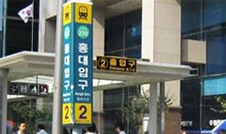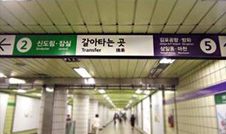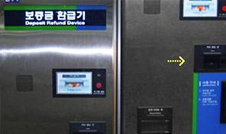| Based on distance traveled |
Classification | Based on transport cards | Single-use card |
|---|---|---|---|
| Adults |
|
100 won added to the transport card fee | |
| Youths (aged 13-19) |
minimum charge: 720 won | minimum charge: 1,350 won | |
| Children (aged 6-12) |
minimum charge: 450 won | minimum charge: 450 won |
* Early Bird Tickets: Passengers who charge their cards with pay-as-you-go credit before 6:30 a.m. will receive 20 percent off the basic fare.
* Permanent residency (F-5) visa holders aged over 65 and residing in Seoul are also entitled to receive the same вАЬfree rides for senior citizensвАЭ benefit as Korean nationals.
A transfer to another line can be done within the station, without passing through the turnstile.
Transferring can be easily done by following the color of the subway line that you want to use.
 |
1. Finding subway stations
* At the entrance of subway stations, there are a subway sign and the station name. Station names are indicated in Chinese and English for foreigners. |
 |
2. Ticket purchasing
* As of May 2009, boarding tickets have been changed to single-use transport cards. Upon the purchase of this type of card, a security deposit of 500 won is added, but it is returned after the card has been used. |
 |
3. Passing through a turnstile
* After purchasing a card, scan the card to pass through the turnstile. |
 |
4. Transfer
* A transfer to another line can be done within the station, without passing through the turnstile. |
 |
5. Exiting
* To leave the subway station, scan the card and pass through the turnstile. |
- Do not push and shove on a crowded train.
- Let passengers get off the train before you board.
- Offer your seat to pregnant women, people with children, and the physically disadvantaged.
- Do not walk or run when riding an escalator.
- Turn your cell phone to vibration mode and keep your voice down while on the phone.
- Do not buy things from peddlers in subway trains.
- Do not run or speak aloud on subway trains.
- Fold up your newspaper for others or take it with you when you get off.
- Keep to the right when walking in subway stations.
- Do not try to get an illegal free ride on a subway train.
Bus System
- 1. Fares can be paid by cash or transportation card. One-time boarding charges a flat-rate fare where you can pay by cash or transportation card
- 2. Fares for Seoul city buses and Maeul (village) buses can be paid by T-money, U-Pass, EB Card, Cashbee, and Korail Membership Card. Deferred payment transportation cards, which are compatible with T-Money and U-Pass, can be used as well.
- 3. Seoul city buses offer a free ride for a maximum of 3 children under the age of 6 so long as they are accompanied by a guardian. Legal free riders who are defined in the Passenger Transport Service Act of Korea are also able to ride for free.
- 4. Seoul, Gyeonggi-do, Incheon buses and metropolitan subways are under the Metropolitan Integrated Fare System, so they charge a basic fare up to 10km. Using Seoul metropolitan buses, Gyeonggi-do general buses, non-stop deluxe buses, Incheon buses, and red buses for more than one transfer will cost a basic rate up to 30km, and you will be charged an extra 100 won for each additional 5 km (based on the adult fare).
- 5. Seoul, Gyeonggi-do, Incheon buses and metropolitan subways are under the Metropolitan Integrated Fare System, so they charge a basic fare up to 10km. Using Seoul metropolitan buses, Gyeonggi-do general buses, non-stop deluxe buses, Incheon buses, and red buses for more than one transfer will cost a basic rate up to 30km, and you will be charged an extra 100 won for each additional 5 km (based on the adult fare).
- 6. Multiple-passenger boarding and a transfer discount are applicable only to city buses, and this offer can be approved only if the same passengers travel to the same destination.
Fare
| Bus Type | Card with  Pay-As-You-Go Credt (KRW) | Cash (KRW) |
|---|---|---|
| Blue Bus/Green Bus | Adult: 1,200 | Adult: 1,300 |
| Adolescent: 720 | Adolescent: 1,000 | |
| Child: 450 | Child: 450 | |
| Red Bus | Adult: 2,300 | Adult: 2,400 |
| Adolescent: 1,360 | Adolescent: 2,400 | |
| Child: 1,200 | Child: 1,200 | |
| Yellow Bus | Adult: 1,100 | Adult: 1,200 |
| Adolescent: 560 | Adolescent: 1,200 | |
| Child: 350 | Child: 350 | |
| Late-Night Bus | Adult: 2,150 | Adult: 2,250 |
| Adolescent: 1,360 | Adolescent: 2,250 | |
| Child: 1,200 | Child: 1,200 | |
| Shuttle (Town) Bus | Adult: 900 | Adult: 1,000 |
| Adolescent: 480 | Adolescent: 1,000 | |
| Child: 300 | Child: 300 |
- T-money Card
-
T-money is a transport card issued by the Korea Smart Card. It can be used as a transport card and e-currency. It is usually used in the metropolitan area, along with Cashbee.
The T-money transport cards are classified as a common T-money card and Smart T-money card. Smart T-money cards are sold in various forms, such as a key ring and a cell phone ring.
T-money cards can be recharged at subway stations and convenience stores.
Seoul Buses Information
- * Yellow Bus : First Number (Areas where buses are operating) / Second Number(serial number (1~))
- * Blue Bus : First Number (Number of departure area) / Second Number (Number of arrival area) / Third Number (serial number (0~))
- * Green Bus : First Number (Number of departure area) / Second Number (Number of arrival area) / Third Number (serial number (11~))
- * Red Bus : First Number (9) / Second Number (Number of departure area) / Third Number (serial number (00~))
- * Customized Bus : First Number (8) / Second Number (departure area) / Third Number (Number of arrival area) / Fourth Number (serial number (0~))
- * Airport Bus : First Number (6(0~7)) / Third Number (serial number (00~))
- * Midnight Bus : First Number (N) / Second Number (Number of departure area) / Third Number (Number of arrival area)
- International Taxi
-
- - International Taxi services basically require a prior reservation via telephone (+82-2-1644-2255) and homepage.
- - Call +82-2-1644-2255 for English/Japanese consultations, which are available all year round 24 hours a day 365 days a year
- - A direct reservation is possible via the homepage for International Taxis
- - Immediate use of the taxi is available even without a prior reservation if there is a taxi that is standing by. 
- Consultation and Reception of Reservation
-
- - Tel :+82-1644-2255
- - Fax :+82-2-2043-1578
- - E-mail : reserve@intltaxi.co.kr
- - Website: http://www.intltaxi.co.kr/ (Korean, English, Japanese, Chinese)
- The Benefits of Using an International Taxi
-
- - The hiring and educating of taxi drivers and call center operations are supervised by the Seoul Metropolitan Government. Taxi drivers have certifications in foreign language proficiency.
- - The information desk and boarding area that are exclusively for International Taxi users are located at the Incheon International Airport and Gimpo International Airport.
- - Payment is possible with credit cards or T-money.
- A Variety of Taxis
-

- Medium Taxi
-
- - These taxis can accommodate up to five passengers. 
- - The basic fare for these taxis is 3,000won for the first 2 km with an increase of 100 won per 142m.
- - The вАЬInternational TaxiвАЭ sign is on the roof of each taxi.
- - If there is no вАЬInternational TaxiвАЭ sign on the roof of the taxi, this taxi is normal medium taxi. Of course, you can take this taxi.
- - Cabs with вАЬJapaneseвАЭ signs mean that the driver can speak Japanese.

- Luxury Taxi
-
- - These taxis can accommodate up to 5 passengers. 
- - The color is black . The sides of the vehicle and the roof lamp will have the вАЬInternational TAXIвАЭ sign.

- Large Taxi
-
- - These taxi vans an accommodate up to nine passengers. 
- - The body of the vehicle is black and вАЬInternational TaxiвАЭ signs are displayed on the sides.

- Luxury Taxi
-
- - These taxis are black with yellow roof lamp. Although considerably more comfortable, these luxury cabs also cost more. 
- - The basic fare is 5,000 won with an increase of 200 won per 3km.

- Free Interpretation
-
- - These taxis have the sign вАЬFree Interpretation,вАЭ¬†
- - Riders have access to free interpretation services in Japanese, English, and Chinese via the use of a cell phone. 
- - If you need the service, simply tell your cab driver, вАЬFree interpretation.вАЭ














